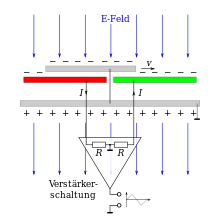Electric field meter

An electrostatic field meter , also electric field meters , rotational voltmeter or field mill ( English "field mill" called), is a device for measuring the electric field strength . If the measuring distance to an object is defined, it can be used as a voltage measuring device.
Like the electroscope , the electric field meter does not draw any energy from the object to be measured and therefore does not falsify the measurement result, but it is much more sensitive. Depending on the design, a resolution of down to 10 V / m (for rotary voltmeters, for more manageable electric field meters only up to about 1 kV / m) can be achieved.
functionality
On the front of the devices there is a gold-plated electrostatic chopper (impeller, hence the name "field mill"). According to some manufacturers, gold reduces the measurement error because it has a similar position to oxygen in the electrochemical series . The impeller periodically releases window openings and closes them again. Therefore, the sensor electrode behind the chopper can alternately charge and discharge due to the influence of the external electric field. This change in charge can be measured in different ways:
- In the simplest case, the sensor electrode is grounded via a very high resistance in order to achieve a sufficiently large time constant . The charge-reversal current then generates an alternating voltage, which is made low-resistance via a voltage follower ( electrometer amplifier ).
- With higher demands, a charge amplifier generates the measuring voltage. Thanks to its virtual zero point, this ensures that the sensor plate always remains at zero potential, which drastically reduces insulation problems.
After sufficient amplification, the AC voltage is rectified and displayed in a synchronous rectifier, the switching frequency of which corresponds to the rotation frequency of the impeller. In this way, the polarity of the voltage or the direction of the electric field can be determined.
This principle enables static electrical charges and fields to be determined without taking energy from them - no current flows for measurement.
Applications

From the measured field strengths, one can infer neighboring surface charges, which have to be avoided, among other things, in electrostatically protected areas (ESD workstations) and in the manufacture and packaging of electronic parts and components. They could lead to electrostatic discharge .
In meteorology and climate research, changes in the electrical field in the earth's atmosphere are measured, which are generated in the atmosphere by weather phenomena such as thunderstorms, cold or warm front passages, rain clouds and other electrostatic phenomena. Missile launches will be postponed if necessary.
See also
Web links
- Description and working method - at www.rapp-instruments.de
- Stefan Kneifels DH1STF (Feldmühle)
- hcrs field mill
- Explanation at student level ( LEIFI )
Individual evidence
- ^ About Electric Field Mill Operation
- ↑ Measurement of electrostatic fields and charges. Fraunhofer IGB, October 24, 2003, archived from the original on March 14, 2005 ; Retrieved October 23, 2011 .
- ↑ Eltex: Product data sheet
- ↑ Electric field meter, USB. (PDF; 502 kB) Operating Instructions. (No longer available online.) PHYWE Systeme GmbH und Co. KG, formerly in the original ; Retrieved July 5, 2016 . ( Page no longer available , search in web archives ) Info: The link was automatically marked as defective. Please check the link according to the instructions and then remove this notice.
- ↑ Florida Airborne Field Mill Research May Improve Launch Weather Criteria Press Release, Kennedy Space Center. Upholstered on spaceref.com July 11, 2000, accessed June 6, 2020.

